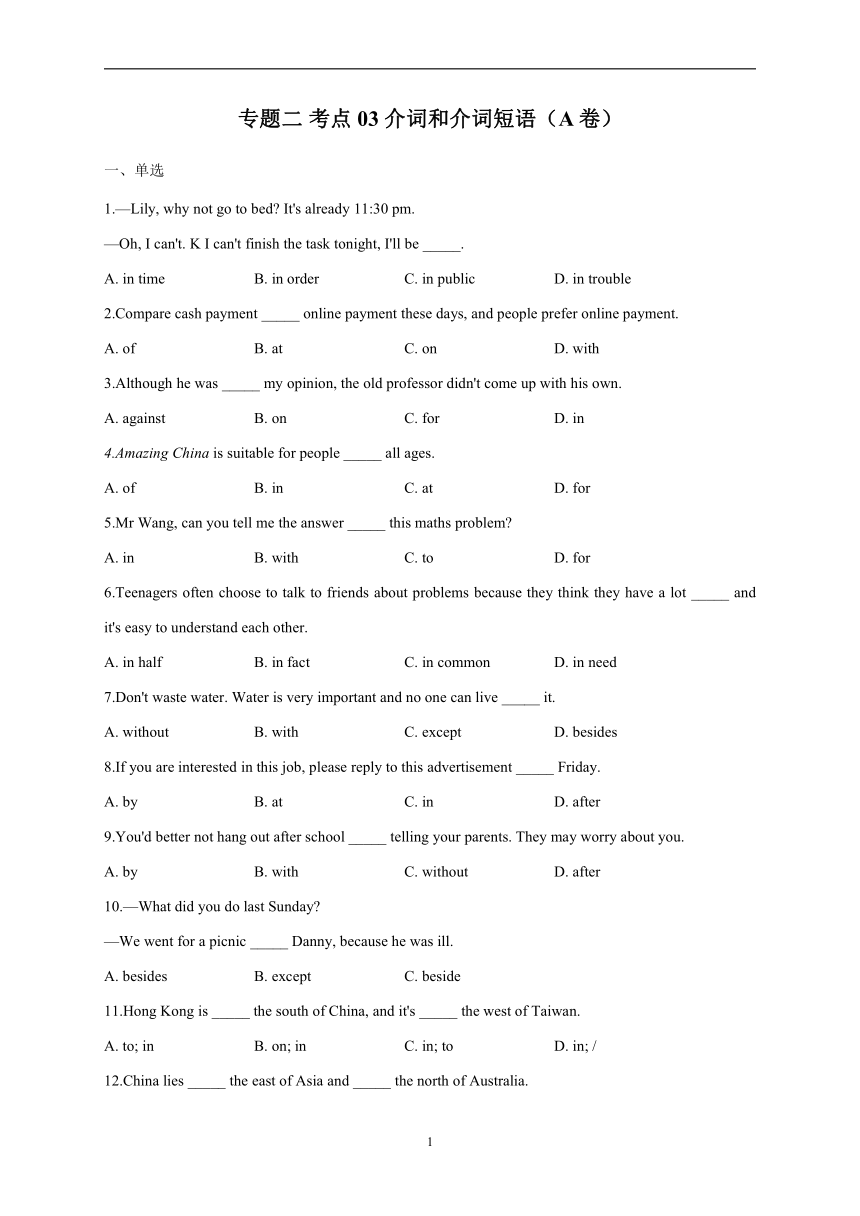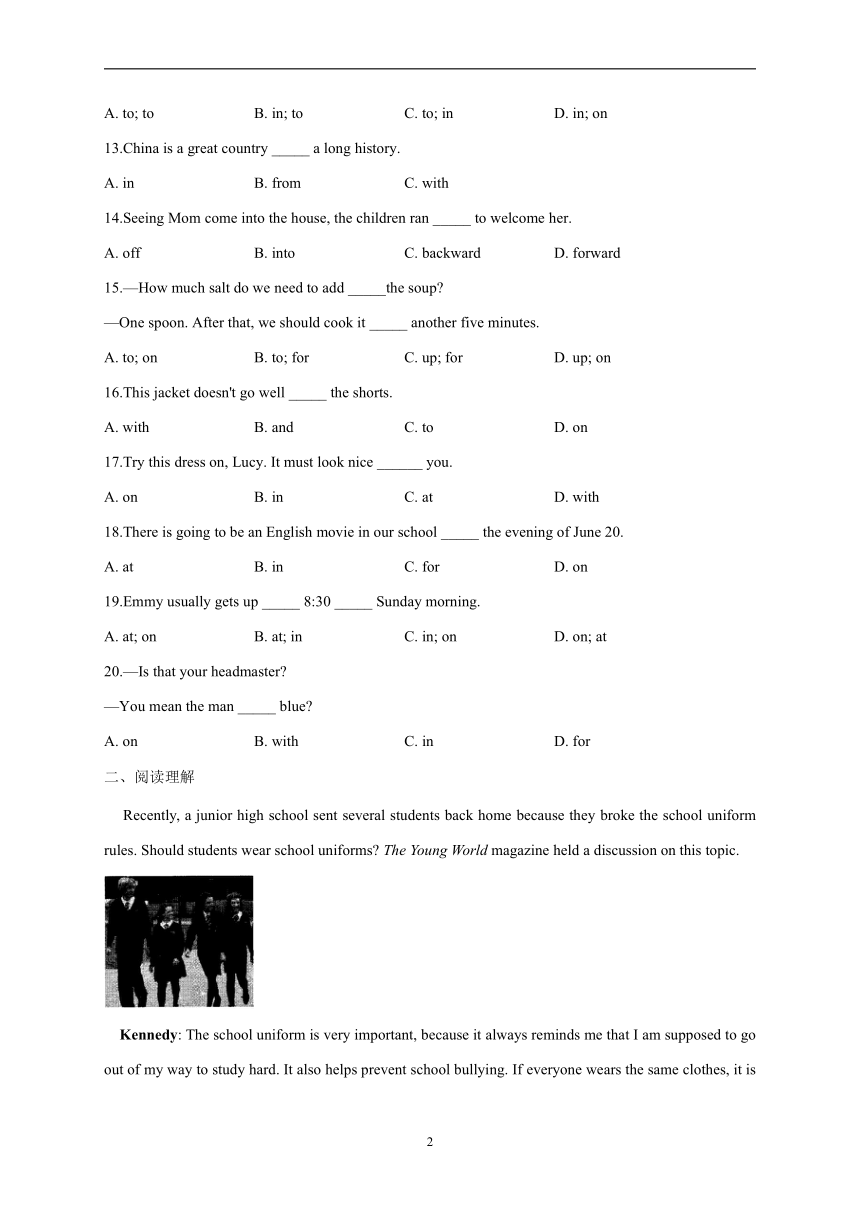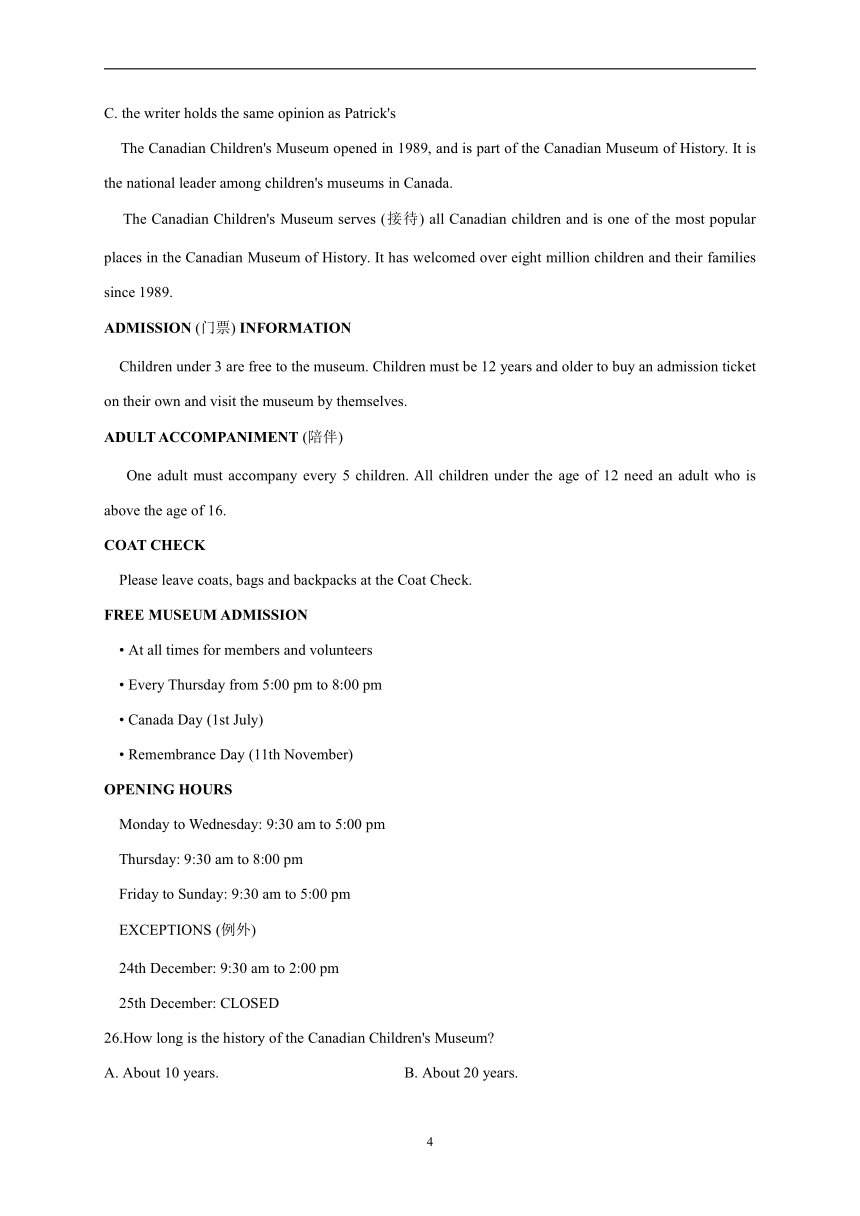2023届中考英语高频考点专项练习:专题二 考点03 介词和介词短语(A卷)(含答案)
文档属性
| 名称 | 2023届中考英语高频考点专项练习:专题二 考点03 介词和介词短语(A卷)(含答案) |  | |
| 格式 | docx | ||
| 文件大小 | 58.4KB | ||
| 资源类型 | 教案 | ||
| 版本资源 | 通用版 | ||
| 科目 | 英语 | ||
| 更新时间 | 2022-12-16 09:27:29 | ||
图片预览




文档简介
专题二 考点03 介词和介词短语(A卷)
一、单选
1.—Lily, why not go to bed It's already 11:30 pm.
—Oh, I can't. K I can't finish the task tonight, I'll be _____.
A. in time B. in order C. in public D. in trouble
2.Compare cash payment _____ online payment these days, and people prefer online payment.
A. of B. at C. on D. with
3.Although he was _____ my opinion, the old professor didn't come up with his own.
A. against B. on C. for D. in
4.Amazing China is suitable for people _____ all ages.
A. of B. in C. at D. for
5.Mr Wang, can you tell me the answer _____ this maths problem
A. in B. with C. to D. for
6.Teenagers often choose to talk to friends about problems because they think they have a lot _____ and it's easy to understand each other.
A. in half B. in fact C. in common D. in need
7.Don't waste water. Water is very important and no one can live _____ it.
A. without B. with C. except D. besides
8.If you are interested in this job, please reply to this advertisement _____ Friday.
A. by B. at C. in D. after
9.You'd better not hang out after school _____ telling your parents. They may worry about you.
A. by B. with C. without D. after
10.—What did you do last Sunday
—We went for a picnic _____ Danny, because he was ill.
A. besides B. except C. beside
11.Hong Kong is _____ the south of China, and it's _____ the west of Taiwan.
A. to; in B. on; in C. in; to D. in; /
12.China lies _____ the east of Asia and _____ the north of Australia.
A. to; to B. in; to C. to; in D. in; on
13.China is a great country _____ a long history.
A. in B. from C. with
14.Seeing Mom come into the house, the children ran _____ to welcome her.
A. off B. into C. backward D. forward
15.—How much salt do we need to add _____the soup
—One spoon. After that, we should cook it _____ another five minutes.
A. to; on B. to; for C. up; for D. up; on
16.This jacket doesn't go well _____ the shorts.
A. with B. and C. to D. on
17.Try this dress on, Lucy. It must look nice ______ you.
A. on B. in C. at D. with
18.There is going to be an English movie in our school _____ the evening of June 20.
A. at B. in C. for D. on
19.Emmy usually gets up _____ 8:30 _____ Sunday morning.
A. at; on B. at; in C. in; on D. on; at
20.—Is that your headmaster
—You mean the man _____ blue
A. on B. with C. in D. for
二、阅读理解
Recently, a junior high school sent several students back home because they broke the school uniform rules. Should students wear school uniforms The Young World magazine held a discussion on this topic.
Kennedy: The school uniform is very important, because it always reminds me that I am supposed to go out of my way to study hard. It also helps prevent school bullying. If everyone wears the same clothes, it is impossible to laugh at other people's clothing.
Manson: The uniform has to be earned (获得) through efforts. Students should start school with no uniforms. As they make progress at school, they start wearing it. I always think children need to be proud of their school. The uniform is important for that. So, make students earn it! If they don't perform well, they should not be allowed to get one.
Moorhead: In my opinion, kids don't have to wear uniforms. There should be more choices open to kids in education. They ought to develop their own independence and just be themselves. Their personalities would be expressed through their own clothes at school. And different dress could be one way of showing their understanding of beauty. Besides, they make the school lively and colourful.
Patrick: I can see the advantages of wearing school uniforms. They play a very important role in managing schools. However, a school should not depend heavily on uniforms to improve students' behaviours. Teaching them how to express themselves with confidence is more important.
21.What does the writer mean to do in Paragraph I
A. Present an opinion on a subject.
B. Introduce a topic for discussion.
C. Provide a way to solve problems.
22.What is Kennedy in the second paragraph
A. A student. B. A teacher. C. A parent.
23.In Manson's opinion, _____.
A. students have the right to get school uniforms for free
B. students should be encouraged to earn school uniforms
C. students performing well needn't wear school uniform
24.According to Patrick, what is more important
A. Managing schools by uniforms.
B. Improving students' behaviours.
C. Helping students express themselves confidently.
25.We can learn from the text that _____.
A. Kennedy can't stand school uniforms
B. Moorhead is against school uniform rules
C. the writer holds the same opinion as Patrick's
The Canadian Children's Museum opened in 1989, and is part of the Canadian Museum of History. It is the national leader among children's museums in Canada.
The Canadian Children's Museum serves (接待) all Canadian children and is one of the most popular places in the Canadian Museum of History. It has welcomed over eight million children and their families since 1989.
ADMISSION (门票) INFORMATION
Children under 3 are free to the museum. Children must be 12 years and older to buy an admission ticket on their own and visit the museum by themselves.
ADULT ACCOMPANIMENT (陪伴)
One adult must accompany every 5 children. All children under the age of 12 need an adult who is above the age of 16.
COAT CHECK
Please leave coats, bags and backpacks at the Coat Check.
FREE MUSEUM ADMISSION
At all times for members and volunteers
Every Thursday from 5:00 pm to 8:00 pm
Canada Day (1st July)
Remembrance Day (11th November)
OPENING HOURS
Monday to Wednesday: 9:30 am to 5:00 pm
Thursday: 9:30 am to 8:00 pm
Friday to Sunday: 9:30 am to 5:00 pm
EXCEPTIONS (例外)
24th December: 9:30 am to 2:00 pm
25th December: CLOSED
26.How long is the history of the Canadian Children's Museum
A. About 10 years. B. About 20 years.
C. About 30 years. D. About 40 years.
27.Who can accompany children in the museum
A. 12-year-old Tom. B. 14-year-old Jake.
C. 15-year-old Sandra. D. 17-year-old Sophia.
28.If you are 14 years old and want free admission to the museum, you should visit it on _____.
A. 1st July B. Thursday morning
C. Christmas Day D. New Year's Day
29.How long is the museum open on 24th December
A. 3. 5 hours. B. 4. 5 hours. C. 7. 5 hours. D. 10. 5 hours.
30.Sam is nine years old. Can he visit it alone
A. Yes, he can. B. No, he can't.
C. He can go with his 14-year-old sister. D. We don't know.
答案以及解析
1.答案:D
解析:句意为:——莉莉,为什么不去睡觉 已经晚上十一点半了。——噢,我不能睡觉。如果今天晚上我不能完成任务,我会有麻烦的。in time意为“及时”; in order意为“按顺序”; in public意为“公开地”; in trouble意为“处于困境”。由语境可知应选D项。
2.答案:D
解析:句意为:如今现金支付与网络支付相比,人们更喜欢网络支付。固定搭配compare…with…意为“比较……与……”,符合语境。故选D项。
3.答案:A
解析:句意为:虽然老教授反对我的看法,但是他没有提出他自己的(看法)。against意为“反对”,符合句意。故选A项。
4.答案:A
解析:句意为:《厉害了,我的国》适合所有年龄段的人们。固定搭配of all ages意为“所有年龄段的”,符合语境。故选A项。
5.答案:C
解析:句意为:王老师,你能告诉我这道数学题的答案吗 the answer to...是固定搭配,意为“……的答案”。故选C项。
6.答案:C
解析:have…in common意为“有……共同之处”,符合语境。in half意为“分成两半”; in fact意为“事实上”; in need意为“在困难中”。故选择C项。
7.答案:A
解析:without意为“没有”; with意为“有”; except意为“除了”; besides意为“除……之外(还)”。结合语境,故选A项。
8.答案:A
解析:句意为:如果你对这份工作感兴趣,请在周五前回复这个广告。by意为“在……之前”,符合语境。故选A项。
9.答案:C
解析:by意为“通过”; with意为“和”; without意为“没有”; after意为“在……之后”。此处表示在没有告诉父母的情况下,故选C项。
10.答案:B
解析:besides意为“除……之外(还有)……”;except意为“除……之外”;beside意为“在……旁边”。根据语境,故选B项。
11.答案:C
解析:香港是中国的一部分,故第一个空用介词in;香港在台湾外且不接壤,故第二个空用介词to。
12.答案:B
解析:句意为:中国位于亚洲东部和澳大利亚的北部。中国在亚洲范围内,所以第一空用介词in;中国和澳大利亚中间隔海,不接壤,所以第二空用介词to。故选B项。
13.答案:C
解析:句意为:中国是一个有着悠久历史的伟大的国家。with a long history意为“有着悠久的历史”,故选C项。
14.答案:D
解析:根据come into the house和welcome her 可知选forward,意为“向前”。
15.答案:B
解析:句意为:——我们需要往汤里面加多少盐 ——一匙。在那之后,我们应该把它再煮5分钟。add…to…意为“把……加到……里”; for常接表示一段时间的单词或短语。因此选择B项。
16.答案:A
解析:go well with.….是固定短语,意为“和……很相配”。故选A项。
17.答案:A
解析:固定短语look nice on sb意为“穿在某人身上好看”。
18.答案:D
解析:表示在具体的某一天的上午、下午、晚上应用介词on,故选D项。
19.答案:A
解析:表示在具体的某一个时刻应用介词at;表示在星期几的上午、中午或下午应用介词on。故选A项。
20.答案:C
解析:“in+颜色”表示“穿……颜色的衣服”,符合语境。
21.答案:B
解析:推理判断题。第一段主要通过几名中学生因违反了学校有关穿校服的规定而被处分的情况来引入要不要穿校服的话题。故选B项。
22.答案:A
解析:细节理解题。根据because it always reminds me that I am supposed to go out of my way to study hard可知,肯尼迪是一名学生,故选A项。
23.答案:B
解析:细节理解题。根据第三段中的“The uniform has to be earned through efforts.”可知曼森认为校服必须通过努力来获取,即学生应该被鼓励获取校服。故选B项。
24.答案:C
解析:细节理解题。根据最后一段中的“Teaching them how to express themselves with confidence is more important.”可知,教孩子如何自信地表达自己更重要,故选C项。
25.答案:B
解析:细节理解题。根据第四段中的“In my opinion, kids don't have to wear uniforms.”和Their personalities would be expressed through their own clothes at school. And different dress could be one way of showing their understanding of beauty.”可知,穆尔黑德反对穿校服的规定,故选B项。
26.答案:C
解析:细节理解题。根据第一段的The Canadian Children's Museum opened in 1989可知应选C项。
27.答案:D
解析:细节理解题。根据ADULT ACCOMPANIMENT下的“All children under the age of 12 need an adult who is above the age of 16.”可知选D项。
28.答案:A
解析:细节理解题。根据FREE MUSEUM ADMISSION部分的介绍可知应选A项。
29.答案:B
解析:细节理解题。根据OPENING HOURS下的“24th December: 9:30 am to 2:00 pm”可知选B项。
30.答案:B
解析:细节理解题。根据ADMISSION INFORMATION下的“Children must be 12 years and older to buy an admission ticket on their own and visit the museum by themselves.”和ADULT ACCOMPANIMENT下的“All children under the age of 12 need an adult who is above the age of 16.”可知选B项。
2
一、单选
1.—Lily, why not go to bed It's already 11:30 pm.
—Oh, I can't. K I can't finish the task tonight, I'll be _____.
A. in time B. in order C. in public D. in trouble
2.Compare cash payment _____ online payment these days, and people prefer online payment.
A. of B. at C. on D. with
3.Although he was _____ my opinion, the old professor didn't come up with his own.
A. against B. on C. for D. in
4.Amazing China is suitable for people _____ all ages.
A. of B. in C. at D. for
5.Mr Wang, can you tell me the answer _____ this maths problem
A. in B. with C. to D. for
6.Teenagers often choose to talk to friends about problems because they think they have a lot _____ and it's easy to understand each other.
A. in half B. in fact C. in common D. in need
7.Don't waste water. Water is very important and no one can live _____ it.
A. without B. with C. except D. besides
8.If you are interested in this job, please reply to this advertisement _____ Friday.
A. by B. at C. in D. after
9.You'd better not hang out after school _____ telling your parents. They may worry about you.
A. by B. with C. without D. after
10.—What did you do last Sunday
—We went for a picnic _____ Danny, because he was ill.
A. besides B. except C. beside
11.Hong Kong is _____ the south of China, and it's _____ the west of Taiwan.
A. to; in B. on; in C. in; to D. in; /
12.China lies _____ the east of Asia and _____ the north of Australia.
A. to; to B. in; to C. to; in D. in; on
13.China is a great country _____ a long history.
A. in B. from C. with
14.Seeing Mom come into the house, the children ran _____ to welcome her.
A. off B. into C. backward D. forward
15.—How much salt do we need to add _____the soup
—One spoon. After that, we should cook it _____ another five minutes.
A. to; on B. to; for C. up; for D. up; on
16.This jacket doesn't go well _____ the shorts.
A. with B. and C. to D. on
17.Try this dress on, Lucy. It must look nice ______ you.
A. on B. in C. at D. with
18.There is going to be an English movie in our school _____ the evening of June 20.
A. at B. in C. for D. on
19.Emmy usually gets up _____ 8:30 _____ Sunday morning.
A. at; on B. at; in C. in; on D. on; at
20.—Is that your headmaster
—You mean the man _____ blue
A. on B. with C. in D. for
二、阅读理解
Recently, a junior high school sent several students back home because they broke the school uniform rules. Should students wear school uniforms The Young World magazine held a discussion on this topic.
Kennedy: The school uniform is very important, because it always reminds me that I am supposed to go out of my way to study hard. It also helps prevent school bullying. If everyone wears the same clothes, it is impossible to laugh at other people's clothing.
Manson: The uniform has to be earned (获得) through efforts. Students should start school with no uniforms. As they make progress at school, they start wearing it. I always think children need to be proud of their school. The uniform is important for that. So, make students earn it! If they don't perform well, they should not be allowed to get one.
Moorhead: In my opinion, kids don't have to wear uniforms. There should be more choices open to kids in education. They ought to develop their own independence and just be themselves. Their personalities would be expressed through their own clothes at school. And different dress could be one way of showing their understanding of beauty. Besides, they make the school lively and colourful.
Patrick: I can see the advantages of wearing school uniforms. They play a very important role in managing schools. However, a school should not depend heavily on uniforms to improve students' behaviours. Teaching them how to express themselves with confidence is more important.
21.What does the writer mean to do in Paragraph I
A. Present an opinion on a subject.
B. Introduce a topic for discussion.
C. Provide a way to solve problems.
22.What is Kennedy in the second paragraph
A. A student. B. A teacher. C. A parent.
23.In Manson's opinion, _____.
A. students have the right to get school uniforms for free
B. students should be encouraged to earn school uniforms
C. students performing well needn't wear school uniform
24.According to Patrick, what is more important
A. Managing schools by uniforms.
B. Improving students' behaviours.
C. Helping students express themselves confidently.
25.We can learn from the text that _____.
A. Kennedy can't stand school uniforms
B. Moorhead is against school uniform rules
C. the writer holds the same opinion as Patrick's
The Canadian Children's Museum opened in 1989, and is part of the Canadian Museum of History. It is the national leader among children's museums in Canada.
The Canadian Children's Museum serves (接待) all Canadian children and is one of the most popular places in the Canadian Museum of History. It has welcomed over eight million children and their families since 1989.
ADMISSION (门票) INFORMATION
Children under 3 are free to the museum. Children must be 12 years and older to buy an admission ticket on their own and visit the museum by themselves.
ADULT ACCOMPANIMENT (陪伴)
One adult must accompany every 5 children. All children under the age of 12 need an adult who is above the age of 16.
COAT CHECK
Please leave coats, bags and backpacks at the Coat Check.
FREE MUSEUM ADMISSION
At all times for members and volunteers
Every Thursday from 5:00 pm to 8:00 pm
Canada Day (1st July)
Remembrance Day (11th November)
OPENING HOURS
Monday to Wednesday: 9:30 am to 5:00 pm
Thursday: 9:30 am to 8:00 pm
Friday to Sunday: 9:30 am to 5:00 pm
EXCEPTIONS (例外)
24th December: 9:30 am to 2:00 pm
25th December: CLOSED
26.How long is the history of the Canadian Children's Museum
A. About 10 years. B. About 20 years.
C. About 30 years. D. About 40 years.
27.Who can accompany children in the museum
A. 12-year-old Tom. B. 14-year-old Jake.
C. 15-year-old Sandra. D. 17-year-old Sophia.
28.If you are 14 years old and want free admission to the museum, you should visit it on _____.
A. 1st July B. Thursday morning
C. Christmas Day D. New Year's Day
29.How long is the museum open on 24th December
A. 3. 5 hours. B. 4. 5 hours. C. 7. 5 hours. D. 10. 5 hours.
30.Sam is nine years old. Can he visit it alone
A. Yes, he can. B. No, he can't.
C. He can go with his 14-year-old sister. D. We don't know.
答案以及解析
1.答案:D
解析:句意为:——莉莉,为什么不去睡觉 已经晚上十一点半了。——噢,我不能睡觉。如果今天晚上我不能完成任务,我会有麻烦的。in time意为“及时”; in order意为“按顺序”; in public意为“公开地”; in trouble意为“处于困境”。由语境可知应选D项。
2.答案:D
解析:句意为:如今现金支付与网络支付相比,人们更喜欢网络支付。固定搭配compare…with…意为“比较……与……”,符合语境。故选D项。
3.答案:A
解析:句意为:虽然老教授反对我的看法,但是他没有提出他自己的(看法)。against意为“反对”,符合句意。故选A项。
4.答案:A
解析:句意为:《厉害了,我的国》适合所有年龄段的人们。固定搭配of all ages意为“所有年龄段的”,符合语境。故选A项。
5.答案:C
解析:句意为:王老师,你能告诉我这道数学题的答案吗 the answer to...是固定搭配,意为“……的答案”。故选C项。
6.答案:C
解析:have…in common意为“有……共同之处”,符合语境。in half意为“分成两半”; in fact意为“事实上”; in need意为“在困难中”。故选择C项。
7.答案:A
解析:without意为“没有”; with意为“有”; except意为“除了”; besides意为“除……之外(还)”。结合语境,故选A项。
8.答案:A
解析:句意为:如果你对这份工作感兴趣,请在周五前回复这个广告。by意为“在……之前”,符合语境。故选A项。
9.答案:C
解析:by意为“通过”; with意为“和”; without意为“没有”; after意为“在……之后”。此处表示在没有告诉父母的情况下,故选C项。
10.答案:B
解析:besides意为“除……之外(还有)……”;except意为“除……之外”;beside意为“在……旁边”。根据语境,故选B项。
11.答案:C
解析:香港是中国的一部分,故第一个空用介词in;香港在台湾外且不接壤,故第二个空用介词to。
12.答案:B
解析:句意为:中国位于亚洲东部和澳大利亚的北部。中国在亚洲范围内,所以第一空用介词in;中国和澳大利亚中间隔海,不接壤,所以第二空用介词to。故选B项。
13.答案:C
解析:句意为:中国是一个有着悠久历史的伟大的国家。with a long history意为“有着悠久的历史”,故选C项。
14.答案:D
解析:根据come into the house和welcome her 可知选forward,意为“向前”。
15.答案:B
解析:句意为:——我们需要往汤里面加多少盐 ——一匙。在那之后,我们应该把它再煮5分钟。add…to…意为“把……加到……里”; for常接表示一段时间的单词或短语。因此选择B项。
16.答案:A
解析:go well with.….是固定短语,意为“和……很相配”。故选A项。
17.答案:A
解析:固定短语look nice on sb意为“穿在某人身上好看”。
18.答案:D
解析:表示在具体的某一天的上午、下午、晚上应用介词on,故选D项。
19.答案:A
解析:表示在具体的某一个时刻应用介词at;表示在星期几的上午、中午或下午应用介词on。故选A项。
20.答案:C
解析:“in+颜色”表示“穿……颜色的衣服”,符合语境。
21.答案:B
解析:推理判断题。第一段主要通过几名中学生因违反了学校有关穿校服的规定而被处分的情况来引入要不要穿校服的话题。故选B项。
22.答案:A
解析:细节理解题。根据because it always reminds me that I am supposed to go out of my way to study hard可知,肯尼迪是一名学生,故选A项。
23.答案:B
解析:细节理解题。根据第三段中的“The uniform has to be earned through efforts.”可知曼森认为校服必须通过努力来获取,即学生应该被鼓励获取校服。故选B项。
24.答案:C
解析:细节理解题。根据最后一段中的“Teaching them how to express themselves with confidence is more important.”可知,教孩子如何自信地表达自己更重要,故选C项。
25.答案:B
解析:细节理解题。根据第四段中的“In my opinion, kids don't have to wear uniforms.”和Their personalities would be expressed through their own clothes at school. And different dress could be one way of showing their understanding of beauty.”可知,穆尔黑德反对穿校服的规定,故选B项。
26.答案:C
解析:细节理解题。根据第一段的The Canadian Children's Museum opened in 1989可知应选C项。
27.答案:D
解析:细节理解题。根据ADULT ACCOMPANIMENT下的“All children under the age of 12 need an adult who is above the age of 16.”可知选D项。
28.答案:A
解析:细节理解题。根据FREE MUSEUM ADMISSION部分的介绍可知应选A项。
29.答案:B
解析:细节理解题。根据OPENING HOURS下的“24th December: 9:30 am to 2:00 pm”可知选B项。
30.答案:B
解析:细节理解题。根据ADMISSION INFORMATION下的“Children must be 12 years and older to buy an admission ticket on their own and visit the museum by themselves.”和ADULT ACCOMPANIMENT下的“All children under the age of 12 need an adult who is above the age of 16.”可知选B项。
2
同课章节目录
- 词法
- 名词
- 动词和动词短语
- 动词语态
- 动词时态
- 助动词和情态动词
- 非谓语动词
- 冠词
- 代词
- 数词和量词
- 形容词副词及其比较等级
- 介词和介词短语
- 连词和感叹词
- 构词法
- 相似、相近词比较
- 句法
- 陈述句
- 一般疑问句和否定疑问句
- 特殊疑问句及选择疑问句
- 反意疑问句
- 存在句(There be句型)
- 宾语从句
- 定语从句
- 状语从句
- 主谓一致问题
- 简单句
- 并列句
- 复合句
- 主谓一致
- 主、表语从句
- 名词性从句
- 直接引语和间接引语
- 虚拟语气
- 感叹句
- 强调句
- 倒装句
- 祈使句
- 句子的成分
- 句子的分类
- 题型专区
- 单项选择部分
- 易错题
- 完形填空
- 阅读理解
- 词汇练习
- 听说训练
- 句型转换
- 补全对话
- 短文改错
- 翻译
- 书面表达
- 任务型阅读
- 语法填空
- 其他资料
